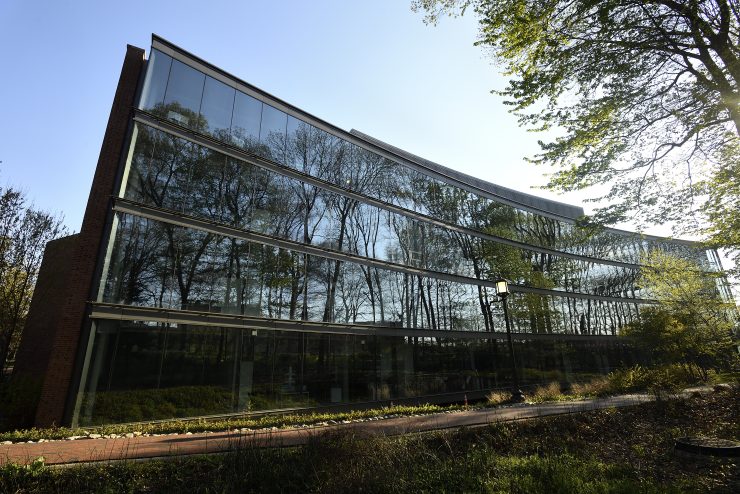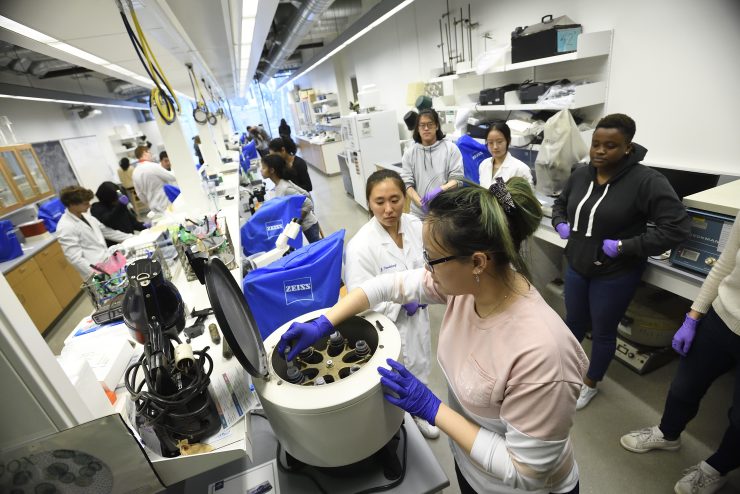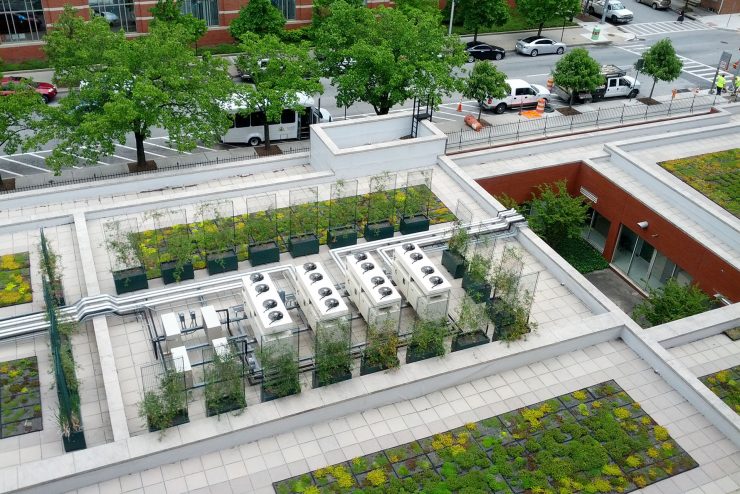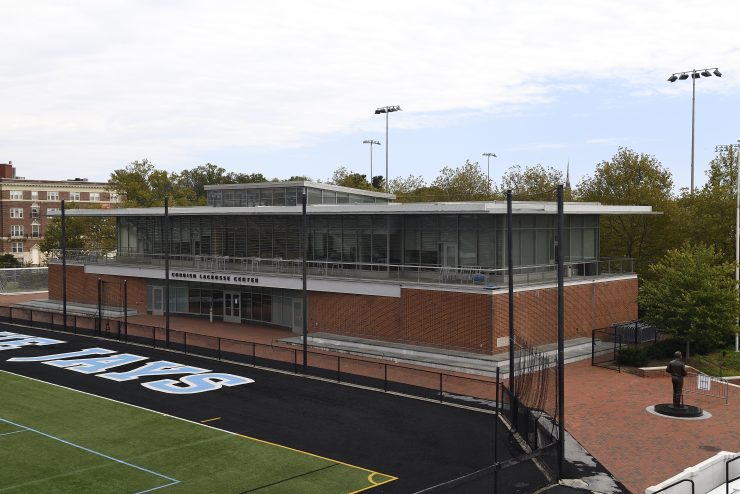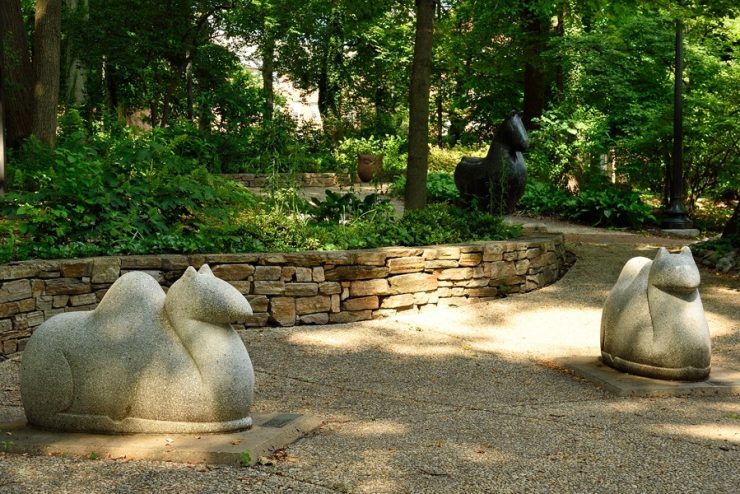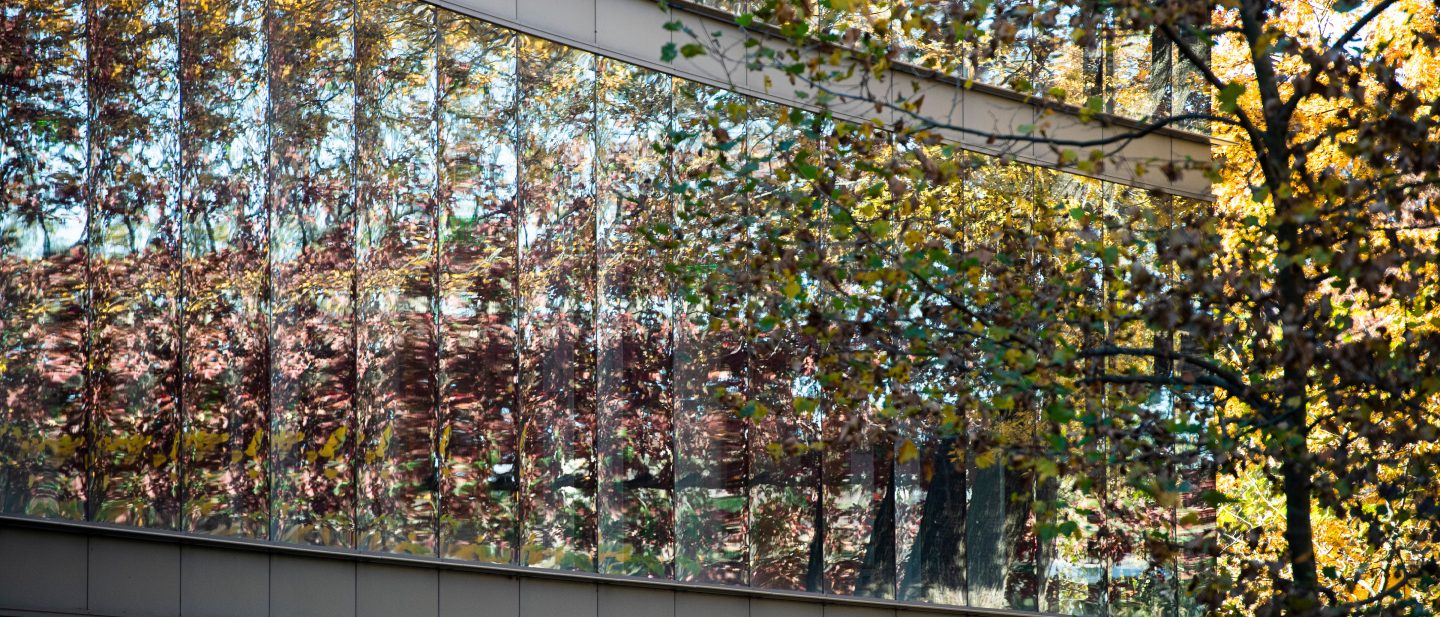
 Designing and Maintaining Buildings and Natural Spaces with Purpose
Designing and Maintaining Buildings and Natural Spaces with Purpose
Addressing sustainability in our buildings and campus spaces is critical to meeting Johns Hopkins University’s climate action goals and protecting the well-being of our community and environment.
Johns Hopkins University buildings are at the heart of our campus community and provide secure spaces to work, live, and learn. However, they also account for approximately 90% of the university’s energy consumption and greenhouse gas emissions. The creation and enforcement of green building standards embeds sustainability through all stages of every project across the institution, enhances positive outcomes for occupants and the environment, and reduces cost premiums associated with sustainability measures. Ensuring the sustainability of our buildings, the sites they occupy, and the infrastructure they rely on also adds to the academic experience on campus and serves as teaching tools that complement curricular learning for students.
As JHU works to address sustainability in its buildings, we are also committed to improving and expanding access to greenspace on our campuses that supports the surrounding regional ecosystems. The university continues to recognize and protect the role of greenspace in providing ecosystem services and social benefits including increased habitat and biodiversity, resilience to climate change, human health and well-being, and improved community linkages.
Built Environment
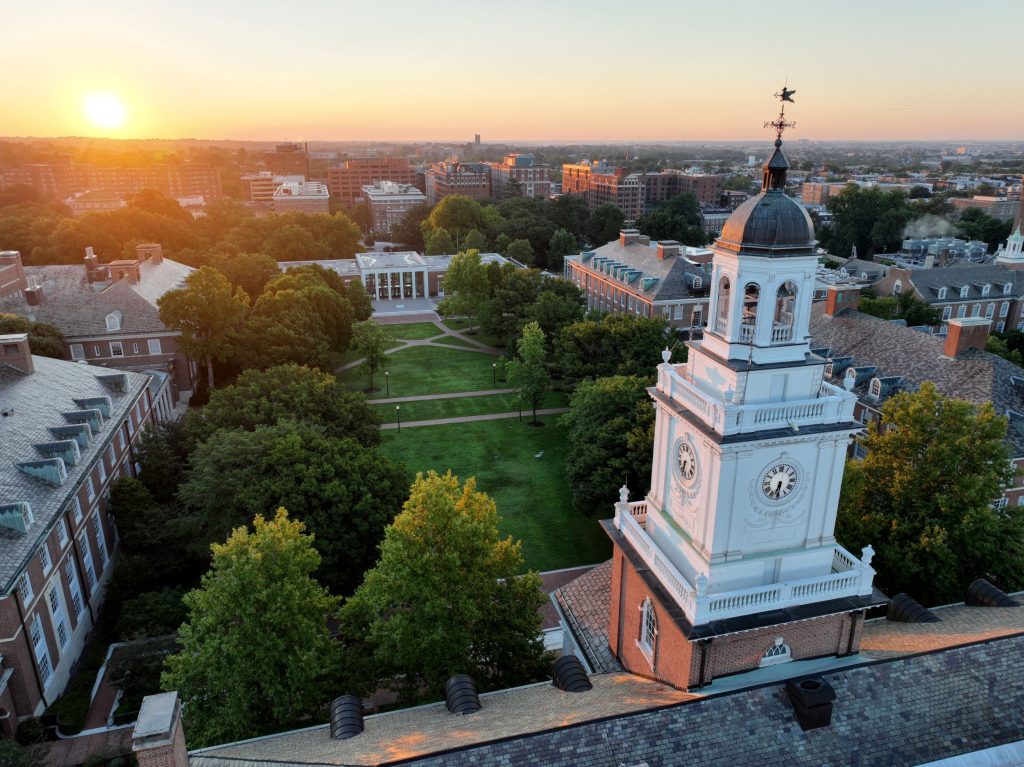
 GOAL 5: Plan, Design, and Operate Buildings and Campuses to Safeguard Environmental and Human Health
GOAL 5: Plan, Design, and Operate Buildings and Campuses to Safeguard Environmental and Human Health
JHU embeds sustainability and health into all campus planning, and designs and operates buildings to reduce emissions and provide healthy environments in which to work, learn, and thrive. The university also commits to aligning our leased spaces with climate and sustainability goals.
High-Performance and Healthy Buildings Requirements
Johns Hopkins University has begun phasing in a new set of requirements aimed at helping design and construction teams meet the university’s ambitious sustainability, health, and well-being goals in campus building projects. The High-Performance and Healthy Buildings (HPHB) Requirements are aimed at integrating sustainability practices consistently within campus capital projects – including new construction, major renovations, and building modifications. Detailed information about the HPHB Requirements can be found here.
LEED-Certified Buildings on JHU’s Campuses
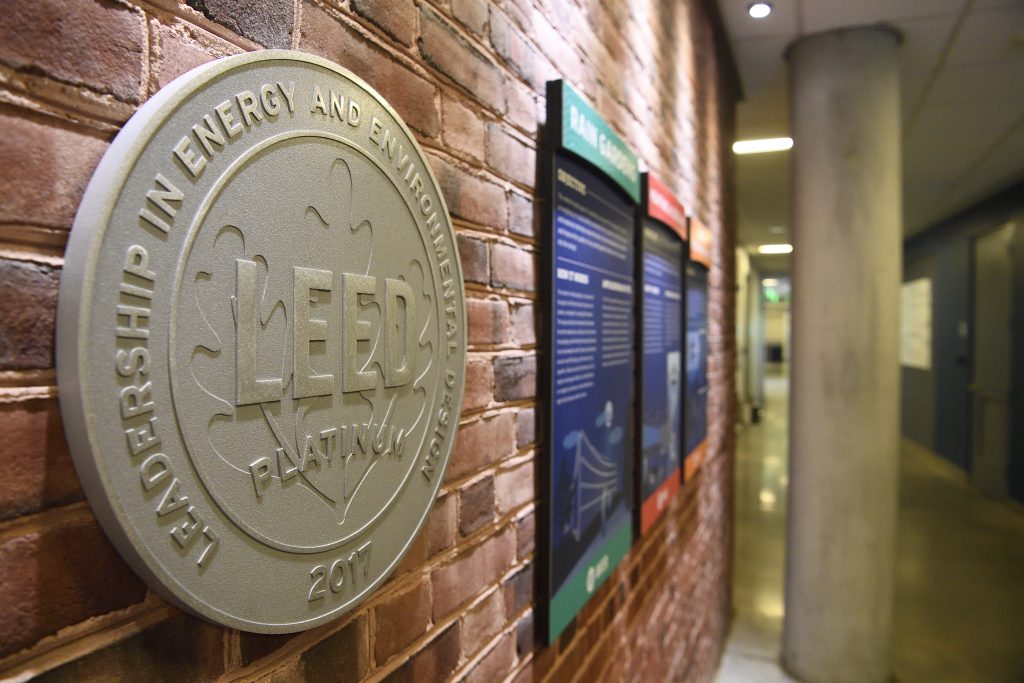
Leadership in Energy and Environmental Design (LEED) is a certification program managed by the U.S. Green Building Council that provides a framework for healthy, efficient, carbon- and cost-saving buildings and is a globally recognized symbol of sustainability achievement. The majority of recent construction and renovation projects at JHU are at least LEED Silver certification; since the adoption of the High-Performance and Health Buildings Requirements in 2025, new construction and major renovations are expected to seek LEED Gold certification as a minimum.
- Bloomberg School of Public Health, Lab Corridors W2600
- Bloomberg School of Public Health, Rangos Suite 600
- Bloomberg School of Public Health, W3700, W3600, and W3300
- Bloomberg School of Public Health, W5010 and W5030 Classroom Renovations
- Homewood, Gilman Hall
- School of Medicine, Cancer Research Building I & II
- School of Medicine, Facilities Management Office
Sustainable Building Spotlight: Undergraduate Teaching Laboratory
The Undergraduate Teaching Laboratory (UTL) is a 105,000 square foot, four-story building equipped with the latest lab technology and received LEED Platinum certification in 2017. Behind the scenes, it is an exemplar of resource conservation, using technologies such as heat recovery wheels, chilled beams, and radiant heating to heat and cool spaces as efficiently as possible, as well as vacuum pumps to improve water use.
Did You Know?
Labs use four to five times more energy per square foot than a typical office building. Learn more about the Green Labs program at JHU and how to get involved.
Natural Environment

 GOAL 6: Design and Steward Landscapes That Enhance Biodiversity, Health, and Community Connections
GOAL 6: Design and Steward Landscapes That Enhance Biodiversity, Health, and Community Connections
JHU is committed to ensuring that campuses have accessible greenspace to enhance biodiversity, support well-being, and increase climate resilience. The university works to protect local water resources through conservation and stormwater management best practices.
Sustainability on Campus Grounds
Sustainability is at the forefront of JHU’s grounds management practices through prioritizing native plant species, working with local nurseries, increasing our campus tree canopy, and much more.
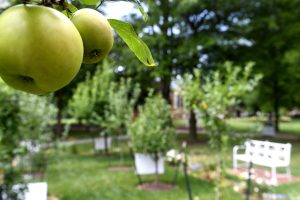 On the Homewood campus, there are several “Big Tree Champions” recognized by the State of Maryland for being the largest tree of that species in the county and at least 70% the size of the State Champion Tree. Other noteworthy trees include an apple and pear orchard planted in 2014 to mirror historical landscape, and a direct scion of the tree Sir Isaac Newton is said to have discovered the law of gravity beneath in 1665.
On the Homewood campus, there are several “Big Tree Champions” recognized by the State of Maryland for being the largest tree of that species in the county and at least 70% the size of the State Champion Tree. Other noteworthy trees include an apple and pear orchard planted in 2014 to mirror historical landscape, and a direct scion of the tree Sir Isaac Newton is said to have discovered the law of gravity beneath in 1665.
Forest Conservation Easement
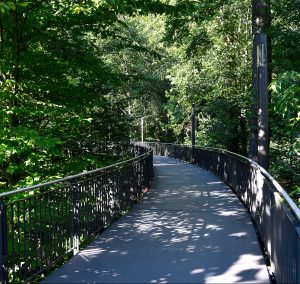 In 2000, JHU established a conservation easement to protect the contiguous forest area on the Homewood campus from further development, as a means of complying with regional guidelines. Preserving this acreage protects important ecosystem services and health benefits, including mitigation of the urban heat island effect, increased groundwater recharge, improved air quality, carbon sequestration, and habitat provision for local biodiversity. It also contributes to Baltimore City’s goal of reaching 40% tree canopy coverage within by 2037.
In 2000, JHU established a conservation easement to protect the contiguous forest area on the Homewood campus from further development, as a means of complying with regional guidelines. Preserving this acreage protects important ecosystem services and health benefits, including mitigation of the urban heat island effect, increased groundwater recharge, improved air quality, carbon sequestration, and habitat provision for local biodiversity. It also contributes to Baltimore City’s goal of reaching 40% tree canopy coverage within by 2037.
Stormwater Management Infrastructure
JHU meets or exceeds all stormwater management guidelines regionally in order to mitigate the impact of stormwater runoff in the Chesapeake Bay Watershed and is currently in the process of updating a Stormwater Master Plan for the Homewood Campus. Examples of green stormwater infrastructure include: the addition of stormwater bioswales, rain gardens, and a series of green roofs located above the South Garage, the Johns Hopkins Hospital, the Cordish Lacrosse Facility, the Fresh Food Café, and the labs at the Bloomberg Center for Physics and Astronomy.
Green Roofs on Campus Buildings
Green roofs across JHU’s campus provide native habitats and improve biodiversity, increase energy efficiency and reduce costs, decrease stormwater runoff, and increase beautification.
Sustainability Spotlight: JHH MRI Building
Johns Hopkins Hospital has 3 green roofs, including more than 65,000 square feet of green roof on the JHH MRI Building.
Sustainability Spotlight: Cordish Lacrosse Facility
A LEED Gold certified building, Cordish Lacrosse Center's green roof both manages stormwater runoff and provides natural heating and cooling capabilities.
Sustainability GIS Map
Discover sustainable features and green spaces on and around the Homewood Campus by exploring our StoryMap and GIS Map.
